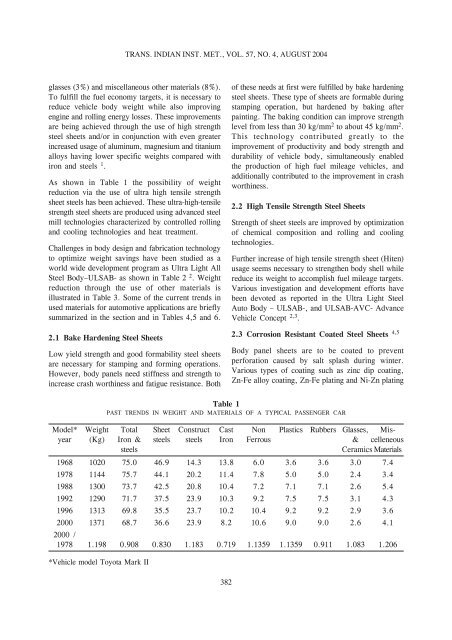HEAT TREATMENT OF AUTOMOTIVE COMPONENTS: CURRENT ...
HEAT TREATMENT OF AUTOMOTIVE COMPONENTS: CURRENT ...
HEAT TREATMENT OF AUTOMOTIVE COMPONENTS: CURRENT ...
You also want an ePaper? Increase the reach of your titles
YUMPU automatically turns print PDFs into web optimized ePapers that Google loves.
TRANS. INDIAN INST. MET., VOL. 57, NO. 4, AUGUST 2004<br />
glasses (3%) and miscellaneous other materials (8%).<br />
To fulfill the fuel economy targets, it is necessary to<br />
reduce vehicle body weight while also improving<br />
engine and rolling energy losses. These improvements<br />
are being achieved through the use of high strength<br />
steel sheets and/or in conjunction with even greater<br />
increased usage of aluminum, magnesium and titanium<br />
alloys having lower specific weights compared with<br />
iron and steels 1 .<br />
As shown in Table 1 the possibility of weight<br />
reduction via the use of ultra high tensile strength<br />
sheet steels has been achieved. These ultra-high-tensile<br />
strength steel sheets are produced using advanced steel<br />
mill technologies characterized by controlled rolling<br />
and cooling technologies and heat treatment.<br />
Challenges in body design and fabrication technology<br />
to optimize weight savings have been studied as a<br />
world wide development program as Ultra Light All<br />
Steel Body–ULSAB- as shown in Table 2 2 . Weight<br />
reduction through the use of other materials is<br />
illustrated in Table 3. Some of the current trends in<br />
used materials for automotive applications are briefly<br />
summarized in the section and in Tables 4,5 and 6.<br />
2.1 Bake Hardening Steel Sheets<br />
Low yield strength and good formability steel sheets<br />
are necessary for stamping and forming operations.<br />
However, body panels need stiffness and strength to<br />
increase crash worthiness and fatigue resistance. Both<br />
of these needs at first were fulfilled by bake hardening<br />
steel sheets. These type of sheets are formable during<br />
stamping operation, but hardened by baking after<br />
painting. The baking condition can improve strength<br />
level from less than 30 kg/mm 2 to about 45 kg/mm 2 .<br />
This technology contributed greatly to the<br />
improvement of productivity and body strength and<br />
durability of vehicle body, simultaneously enabled<br />
the production of high fuel mileage vehicles, and<br />
additionally contributed to the improvement in crash<br />
worthiness.<br />
2.2 High Tensile Strength Steel Sheets<br />
Strength of sheet steels are improved by optimization<br />
of chemical composition and rolling and cooling<br />
technologies.<br />
Further increase of high tensile strength sheet (Hiten)<br />
usage seems necessary to strengthen body shell while<br />
reduce its weight to accomplish fuel mileage targets.<br />
Various investigation and development efforts have<br />
been devoted as reported in the Ultra Light Steel<br />
Auto Body – ULSAB-, and ULSAB-AVC- Advance<br />
Vehicle Concept 2,3 .<br />
2.3 Corrosion Resistant Coated Steel Sheets 4,5<br />
Body panel sheets are to be coated to prevent<br />
perforation caused by salt splash during winter.<br />
Various types of coating such as zinc dip coating,<br />
Zn-Fe alloy coating, Zn-Fe plating and Ni-Zn plating<br />
Table 1<br />
PAST TRENDS IN WEIGHT AND MATERIALS <strong>OF</strong> A TYPICAL PASSENGER CAR<br />
Model* Weight Total Sheet Construct Cast Non Plastics Rubbers Glasses, Misyear<br />
(Kg) Iron & steels steels Iron Ferrous & celleneous<br />
steels Ceramics Materials<br />
1968 1020 75.0 46.9 14.3 13.8 6.0 3.6 3.6 3.0 7.4<br />
1978 1144 75.7 44.1 20.2 11.4 7.8 5.0 5.0 2.4 3.4<br />
1988 1300 73.7 42.5 20.8 10.4 7.2 7.1 7.1 2.6 5.4<br />
1992 1290 71.7 37.5 23.9 10.3 9.2 7.5 7.5 3.1 4.3<br />
1996 1313 69.8 35.5 23.7 10.2 10.4 9.2 9.2 2.9 3.6<br />
2000 1371 68.7 36.6 23.9 8.2 10.6 9.0 9.0 2.6 4.1<br />
2000 /<br />
1978 1.198 0.908 0.830 1.183 0.719 1.1359 1.1359 0.911 1.083 1.206<br />
*Vehicle model Toyota Mark II<br />
382
















